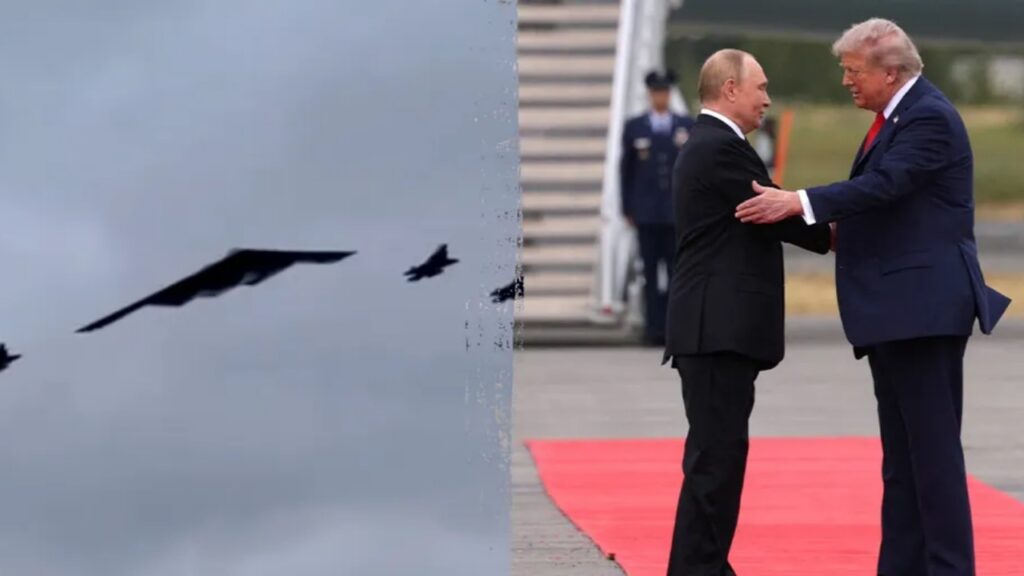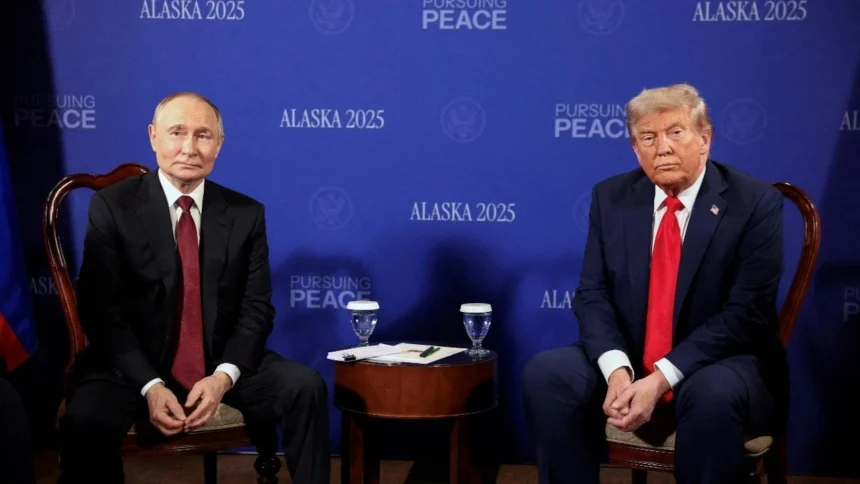The Alaska summit between President Donald Trump and Russian President Vladimir Putin on August 15, 2025, was long anticipated as a possible turning point in the ongoing Russia-Ukraine conflict. Instead, it delivered a spectacle heavy on optics and short on substance.
No deal was reached, but the ramifications for Ukraine and the broader global order may prove profound.
Alaska Summit Was A Stage-Managed Encounter
From the outset, the summit was marked by orchestrated pageantry. President Trump welcomed Putin to a U.S. military base in Anchorage with a literal red carpet and even a B-2 stealth bomber flyover—a stark symbol of American nuclear might and a jarring backdrop for any peace discussion involving a country under U.S. sanctions and an international warrant for war crimes.
Yet the tone was anything but combative: Trump and Putin laughed together, praised each other in public remarks, and spoke of “great progress” while studiously avoiding specifics. Except, the American press behaviour, everything looked pleasant.
This warm reception effectively ended Putin’s years of diplomatic isolation by the West following the 2022 invasion of Ukraine. For Putin, it marked a dramatic triumph: being treated not as a pariah but as a peer, with all the optics of restored legitimacy without making any formal concessions on Ukraine. The Western perception about Putin being isolated vanished again.
Trump-Putin Meeting Was Substance Without Solutions
Beneath the surface-level camaraderie, the harsh geopolitical realities proved intractable. Despite President Trump’s insistence that he could broker a ceasefire and his warnings of “severe consequences” for continued Russian aggression, the meeting produced no clear progress on ending the Ukraine war.
The Western Media, which was questioning Trump for not involving Zelensky in an important talk, once again showed their hypocritical face by highlighting “No Peace Deal in Alaska.” The talk was less about breaking a peace deal and more about reaching a table where two mighty leaders can meet and have their words exchanged.
Though the summit concluded with vague talk of “understandings” and “headway,” neither leader elaborated on any actionable outcomes. Trump stated, “There is no deal until there is a deal,” and Putin simply noted they had established a “businesslike and trustworthy contact.” The absence of specifics—and the refusal to take questions from the press—left the world no closer to a resolution.

President Volodymyr Zelensky of Ukraine was notably absent from the discussions. It reinforced fears among Ukrainians and Europeans that their fate might be negotiated without their input. Ukrainian officials expressed deep concerns about potential “land-swapping” deals that Trump, drawing on his real estate background, has floated as a shortcut to peace. Zelensky has firmly rejected ceding any Ukrainian territory—an idea that would cause political turmoil in Kyiv and ultimately serve Russian objectives.
Vladimir Putin’s Tactical Gain Against Donald Trump
While Trump returned home empty-handed on tangible outcomes, Putin emerged with significant intangible gains. The summit allowed him to project Russian power on American soil, to Western and domestic audiences alike, while making no public promises to halt attacks.
Russian state media heralded the meeting as the defeat of the West’s isolation strategy, and Kremlin strategists saw it as an opportunity to both delay new U.S. sanctions and further complicate Western unity.
Putin leveraged the event to reinforce narratives blaming Ukraine for the conflict’s roots. He had well established that any settlement must begin with his terms. Even as he suggested a willingness to work with Trump, he offered nothing concrete and continued to depict Zelensky as the main obstacle to peace.
However, anyone who is closely monitoring the Russia-Ukraine war can see Zelensky and other Western leaders such as French Emanual Macron, UK PM Khmer Starmer, and newly elected German Chancellor Friedrich Merz have been the major hurdles in the peace process, where Trump and Putin have shown willingness to bring the war to an end.
Double-Edged Risk For Donald Trump
For President Trump, the summit presented both opportunity and risk. Eager to showcase his negotiating prowess and fulfil campaign promises of being the peacemaker, he exposed himself to criticism for putting optics and quick solutions ahead of substantive diplomacy.
His effusive praise for Putin—and refusal to press him publicly on war or election interference—echoed patterns seen in the Helsinki summit during his first term. However, he knows there is no meaning in highlighting these events which may derail the peace process; rather, he chose a friendly path where both leaders can meet, talk and reach an understanding on the peace deal.
Meanwhile, the spectacle played poorly among key U.S. allies. NATO members and European governments, already unsettled by Trump’s hints at a dealmaking approach that sidesteps Ukraine, worried that the U.S. was throwing a geopolitical lifeline to Moscow. The summit’s very existence deepened divisions among Western allies and signalled to Moscow that Trump was willing to operate independently of European consensus.
No Deal, Disrupted Order
The Alaska summit did not deliver peace for Ukraine. Instead, it delivered a powerful moment of political theatre that redefined diplomatic alliances and emboldened Russia, at least in the short term. The event highlighted the benefits of personal diplomacy in solving entrenched conflicts.
Both Trump and Putin departed Alaska, claiming progress but providing no proof. It left Ukraine’s fate unresolved and the balance of power in flux. For now, the only clear winners are the Kremlin and Washington, whose Putin has stepped out of isolation and onto the world stage on his own terms, and Trump can show the world his efforts that he is working hard to bring peace in Ukraine, which will boost his candidature for the Nobel Peace Prize.




